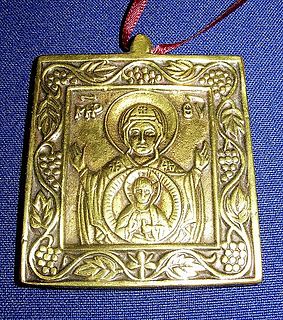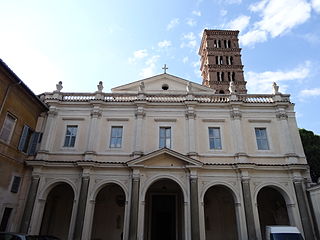
The term Black Madonna or Black Virgin tends to refer to statues or paintings in Western Christendom of the Blessed Virgin Mary and the Infant Jesus, where both figures are depicted as black. The Black Madonna can be found both in Catholic and Orthodox countries.

Madonna Della Strada or Santa Maria Della Strada is a painting of the Blessed Virgin Mary enshrined at the Church of the Gesù in Rome, mother church of the Society of Jesus (Jesuits) religious order of the Catholic Church; it is a variation on the basilissa (imperial) type of icon.

The Servite Order, officially known as the Order of Servants of Mary, is one of the five original Catholic mendicant orders. It includes several branches of friars, contemplative nuns, a congregation of active religious sisters, and lay groups. The Order's objectives are the sanctification of its members, the preaching of the Gospel, and the propagation of devotion to the Mother of God, with special reference to her sorrows. The Servites friars lead a community life in the tradition of the mendicant orders.

Saint Alexiusof Rome or Alexius of Edessa also Alexis) was a fourth-century monk who lived in anonymity and is known for his dedication to Christ. There are two versions of his life that are known, a Syriac one and a Greek one.

The Basilica of Santa Maria in Trastevere ; English: Our Lady in Trastevere) is a titular minor basilica in the Trastevere district of Rome, and one of the oldest churches of Rome. The basic floor plan and wall structure of the church date back to the 340s, and much of the structure to 1140–43. The first sanctuary was built in 221 and 227 by Pope Callixtus I and later completed by Pope Julius I. The church has large areas of important mosaics from the late 13th century by Pietro Cavallini.

Our Lady of Perpetual Help is a Roman Catholic title of the Blessed Virgin Mary associated with a 15th-century Byzantine icon with an alleged Marian apparition. The icon is believed to have originated from the Keras Kardiotissas Monastery and has been in Rome since 1499. Today it is permanently enshrined in the Church of Saint Alphonse of Liguori, where the official Novena to Our Mother of Perpetual Help text is prayed weekly.

Salus Populi Romani is a Roman Catholic title associated with the venerated image of the Blessed Virgin Mary in Rome. This Byzantine icon of the Madonna and Christ Child holding a Gospel book on a gold ground, now heavily overpainted, is kept in the Borghese (Pauline) Chapel of the Basilica of Saint Mary Major.

Antoniazzo Romano, born Antonio di Benedetto Aquilo degli Aquili was an Italian Early Renaissance painter, the leading figure of the Roman school during the latter part of the 15th century. He "made a speciality of repainting or interpreting older images, or generating new cult images with an archaic flavor", in particular by very often using the gold ground style, which was unusual by this period.

The Solemnity of Mary, the Holy Mother of God is a feast day of the Blessed Virgin Mary under the aspect of her motherhood of Jesus Christ, whom she had circumcised on the 8th day, according to the Levitical Law. Christians see him as the Lord, the Son of God. It is celebrated by the Roman Rite of the Catholic Church on 1 January, the Octave (8th) day of Christmastide. The solemnity is a Holy Day of Obligation in areas that have not abrogated it.

The Basilica dei Santi Bonifacio e(d) Alessio is a basilica, rectory church served by the Somaschans, and titular church for a cardinal-priest on the Aventine Hill in the third prefecture of central Rome, Italy.

Santa Maria in Campitelli or Santa Maria in Portico is a church dedicated to the Virgin Mary on the narrow Piazza di Campitelli in Rione Sant'Angelo, Rome, Italy.

Santa Maria dei Monti is a cardinalatial titular church, located at 41 Via della Madonna dei Monti, at the intersection with Via dei Serpenti, in the rione Monti of Rome, Italy. The church is dedicated to the Blessed Virgin Mary.

Acheiropoieta — also called icons made without hands — are Christian icons which are said to have come into existence miraculously; not created by a human. Invariably these are images of Jesus or the Virgin Mary. The most notable examples that are credited by tradition among the faithful are, in the Eastern church the Mandylion, also known as the Image of Edessa, and the Hodegetria, and several Russian icons, and in the West the Shroud of Turin, Veil of Veronica, Our Lady of Guadalupe, and Manoppello Image. The term is also used of icons that are only regarded as normal human copies of a miraculously created original archetype.

Our Lady of Confidence, also known as La Madonna della Fiducia or Our Lady of Trust, is a venerated image depicting the Blessed Virgin Mary enshrined at the Lateran Basilica. The feast of Our Lady of Confidence falls on the last Saturday prior to Lent.

Christ in Majesty or Christ in Glory is the Western Christian image of Christ seated on a throne as ruler of the world, always seen frontally in the centre of the composition, and often flanked by other sacred figures, whose membership changes over time and according to the context. The image develops from Early Christian art, as a depiction of the Heavenly throne as described in 1 Enoch, Daniel 7, and The Apocalypse of John. In the Byzantine world, the image developed slightly differently into the half-length Christ Pantocrator, "Christ, Ruler of All", a usually unaccompanied figure, and the Deesis, where a full-length enthroned Christ is entreated by Mary and St. John the Baptist, and often other figures. In the West, the evolving composition remains very consistent within each period until the Renaissance, and then remains important until the end of the Baroque, in which the image is ordinarily transported to the sky.

The Basilica of Saint Nicolas of Tolentino is a Roman Catholic church and minor basilica that is part of the Augustinian monastery in the hill-town of Tolentino, province of Macerata, Marche, central Italy. The church is a former cathedral of the Roman Catholic Diocese of Tolentino, suppressed in 1586.

The Blessed Virgin Mary has been one of the major subjects of Western Art for centuries. Numerous pieces of Marian art in the Catholic Church covering a range of topics have been produced, from masters such as Michelangelo and Botticelli to works made by unknown peasant artisans.

The Blessed Virgin of Ta' Pinu, or as it is known in Maltese, "Il-Madonna ta' Pinu" is a religious devotion which originated on Gozo, the sister island of Malta. The many Maltese and Gozitans living abroad have managed to spread this devotion in many other parts of the world. The Ta' Pinu Basilica, is based in Għarb.

The Panagia Agiosoritissa or Hagiosoritissa is the name for a type of Marian icon, showing Mary without child, slightly from the side with both hands raised in prayer.
Sant'Alessio may refer to:




















